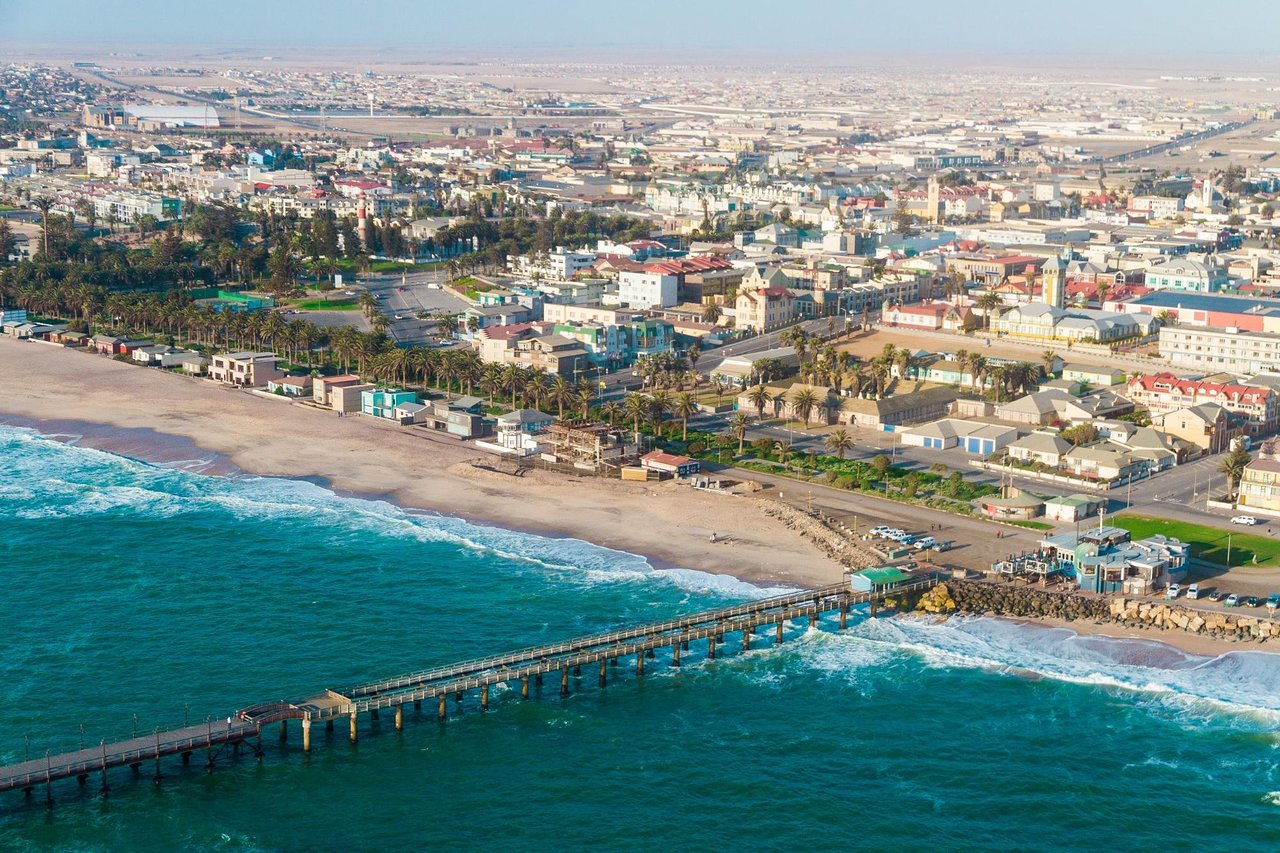Namibia is a country where nature’s raw beauty and rich cultural heritage come together to create an unforgettable experience. From the towering dunes of the Namib Desert to the rugged mountains and expansive savannas, Namibia’s landscapes are as diverse as they are breathtaking. The country is known for its unique wildlife, ancient traditions, and a history that has shaped its modern identity. With a population that is as resilient as it is welcoming, Namibia offers travelers an opportunity to explore a land of contrasts and endless horizons.
Table of Contents
Geography
Namibia is located in southwestern Africa, covering an area of approximately 825,615 square kilometers. It is bordered by Angola to the north, Zambia to the northeast, Botswana to the east, and South Africa to the south, with the Atlantic Ocean along its western coast. The country is dominated by the Namib Desert, which stretches along the coast and is considered one of the oldest deserts in the world. The central plateau, where the capital city of Windhoek is located, runs from north to south and is home to the majority of the population. The Kalahari Desert, another significant feature, extends into eastern Namibia.
Namibia’s climate varies from desert to semi-arid, with the coastal areas experiencing cooler temperatures due to the cold Benguela Current. Rainfall is generally low, with most precipitation occurring during the summer months from January to March. The country is home to diverse ecosystems, including deserts, savannas, and wetlands, which support a wide variety of flora and fauna.
States of Namibia
Namibia is divided into 14 regions, not states. These regions are further subdivided into constituencies. Here’s a table of Namibia’s regions along with their capitals:
| No. | Region | Capital |
|---|---|---|
| 1 | Khomas | Windhoek |
| 2 | Erongo | Swakopmund |
| 3 | Otjozondjupa | Otjiwarongo |
| 4 | Oshana | Oshakati |
| 5 | Omusati | Outapi |
| 6 | Ohangwena | Eenhana |
| 7 | Kavango East | Rundu |
| 8 | Kavango West | Nkurenkuru |
| 9 | Zambezi | Katima Mulilo |
| 10 | Kunene | Opuwo |
| 11 | Namibia | Windhoek |
| 12 | Hardap | Mariental |
| 13 | Karas | Keetmanshoop |
| 14 | Erongo | Swakopmund |
History
Namibia’s history is deeply intertwined with the legacies of its indigenous peoples, colonial rule, and the struggle for independence. The San people are among the earliest inhabitants of the region, leaving behind a rich heritage of rock art that dates back thousands of years. These early inhabitants lived as hunter-gatherers, developing a profound connection with the land. As different ethnic groups migrated into the area, they brought their own cultures, traditions, and languages, creating a diverse mosaic of communities throughout Namibia.
In the late 19th century, Namibia became a German colony known as German South-West Africa. This period was marked by significant conflict, particularly the Herero and Namaqua genocide from 1904 to 1907, which saw the systematic extermination of the Herero and Nama peoples by German colonial forces. Following Germany’s defeat in World War I, Namibia was placed under South African administration, leading to decades of apartheid policies and racial discrimination. The struggle against colonial rule intensified, with various movements advocating for independence and the rights of the indigenous peoples.
Namibia’s quest for independence culminated in the late 20th century, with the formation of the South West Africa People’s Organization (SWAPO) leading the liberation struggle. After years of armed conflict and negotiations, Namibia finally achieved independence on March 21, 1990, becoming one of the last African nations to do so. Sam Nujoma, a key figure in the independence movement, was elected as the country’s first president. Since then, Namibia has made significant strides in nation-building and development, while also addressing the historical injustices faced by its people.
Top Ten Must-Visit Destinations
Sossusvlei

Sossusvlei, located in the heart of the Namib Desert, is one of Namibia’s most iconic landscapes. Famous for its towering red sand dunes, some of which rise over 300 meters high, Sossusvlei offers breathtaking views, particularly at sunrise when the dunes glow with vibrant colors. The area is also home to the dead tree skeletons of Deadvlei, a striking contrast against the bright orange sand. Visitors can explore the dunes by climbing to the top of Dune 45 or enjoying a scenic hot air balloon ride for an aerial perspective of this stunning desert landscape.
Etosha National Park
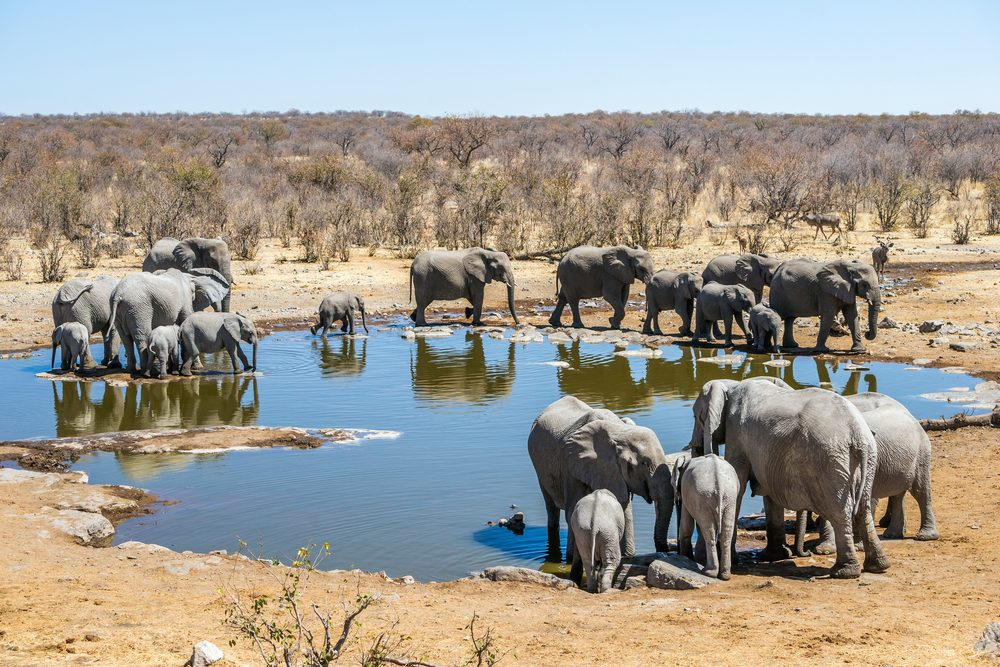
Etosha National Park is one of Africa’s premier wildlife destinations, covering an area of approximately 22,912 square kilometers. The park is centered around the vast Etosha Pan, a salt flat that becomes a magnet for wildlife, especially during the dry season. Visitors can expect to see elephants, lions, giraffes, and numerous antelope species, as well as a variety of birdlife. The park features several waterholes where animals congregate, offering excellent opportunities for game viewing and photography. The park is also home to unique vegetation and stunning landscapes, making it a must-visit for nature enthusiasts.
Fish River Canyon
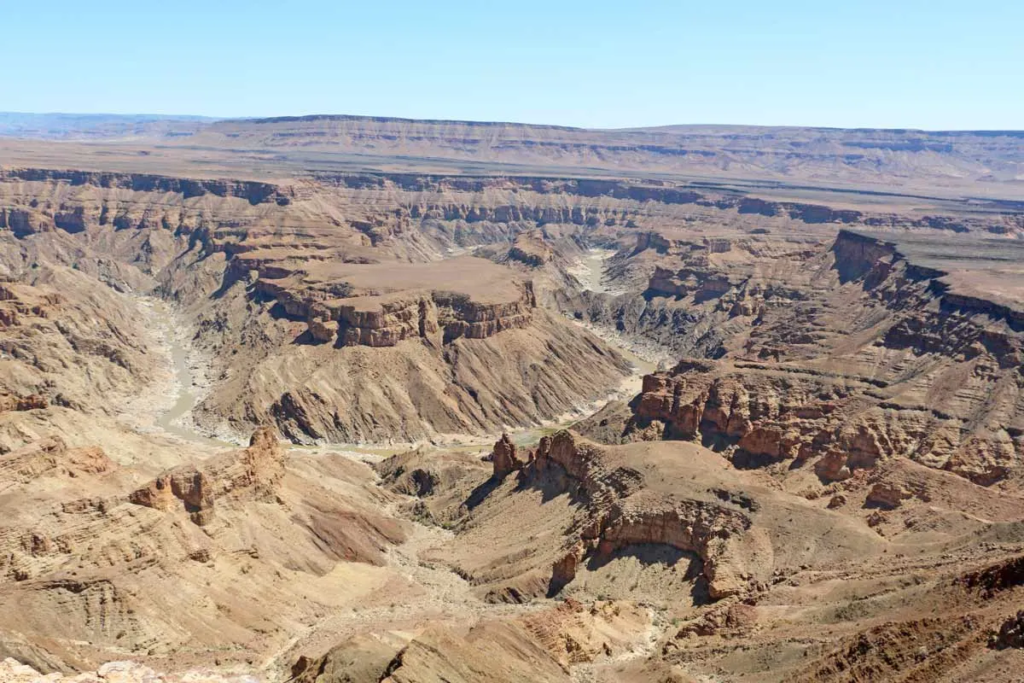
Fish River Canyon is a geological marvel and one of the largest canyons in the world, measuring approximately 160 kilometers long and up to 27 kilometers wide. The canyon was formed over millions of years by geological forces and erosion, creating dramatic cliffs and stunning views. Visitors can hike along the rim or embark on a multi-day trek along the Fish River, which offers breathtaking scenery and a chance to experience the rugged beauty of Namibia’s landscapes. The best time to visit is during the cooler months from May to September.
Swakopmund

Swakopmund is a charming coastal town known for its German colonial architecture and vibrant adventure tourism. Located between the Atlantic Ocean and the Namib Desert, the town offers a unique blend of cultural experiences and outdoor activities. Visitors can enjoy a variety of adventure sports, including sandboarding, quad biking, and skydiving, while the picturesque beachfront and promenade provide a relaxing escape. Swakopmund also features museums, art galleries, and markets that showcase the local culture and history.
Damaraland
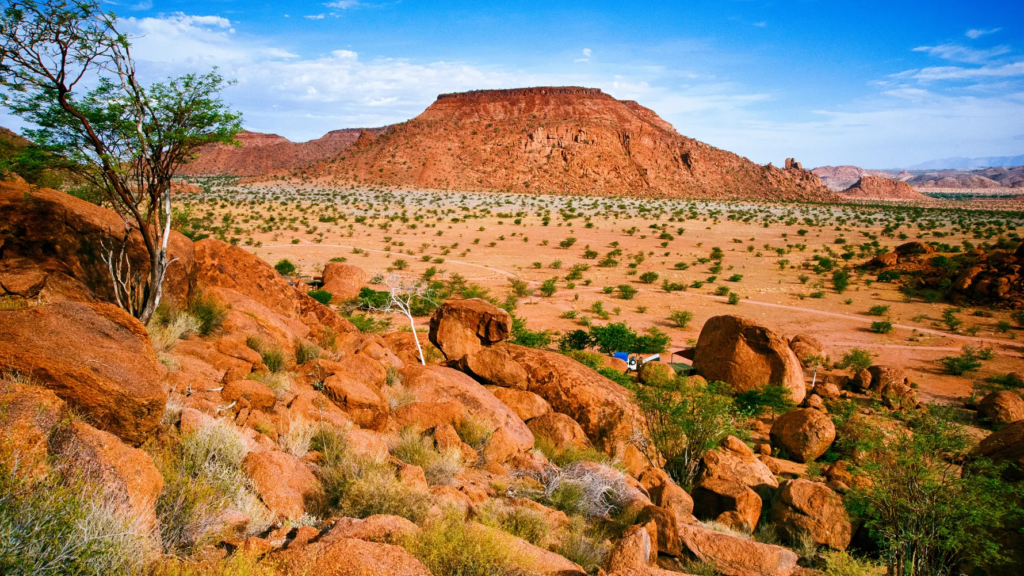
Damaraland is a region known for its unique landscapes, ancient rock engravings, and diverse wildlife, including the rare desert-adapted elephants. The area is home to the famous Brandberg Mountain, which boasts some of the country’s most important rock art sites, including the White Lady painting. Damaraland offers opportunities for hiking, wildlife viewing, and exploring the stunning natural features, such as the Organ Pipes and the Petrified Forest. The region’s dramatic scenery and rich cultural heritage make it a captivating destination for travelers.
Spitzkoppe

Spitzkoppe, often referred to as the “Matterhorn of Namibia,” is a group of bald granite peaks rising dramatically from the surrounding plains. The area is a paradise for rock climbers and hikers, offering stunning views and unique rock formations. Visitors can explore the numerous hiking trails, discover ancient rock art left by the San people, and camp under the stars in this breathtaking setting. The picturesque landscape, combined with the sense of tranquility, makes Spitzkoppe a must-visit for nature lovers and adventure seekers alike.
Namib-Naukluft National Park
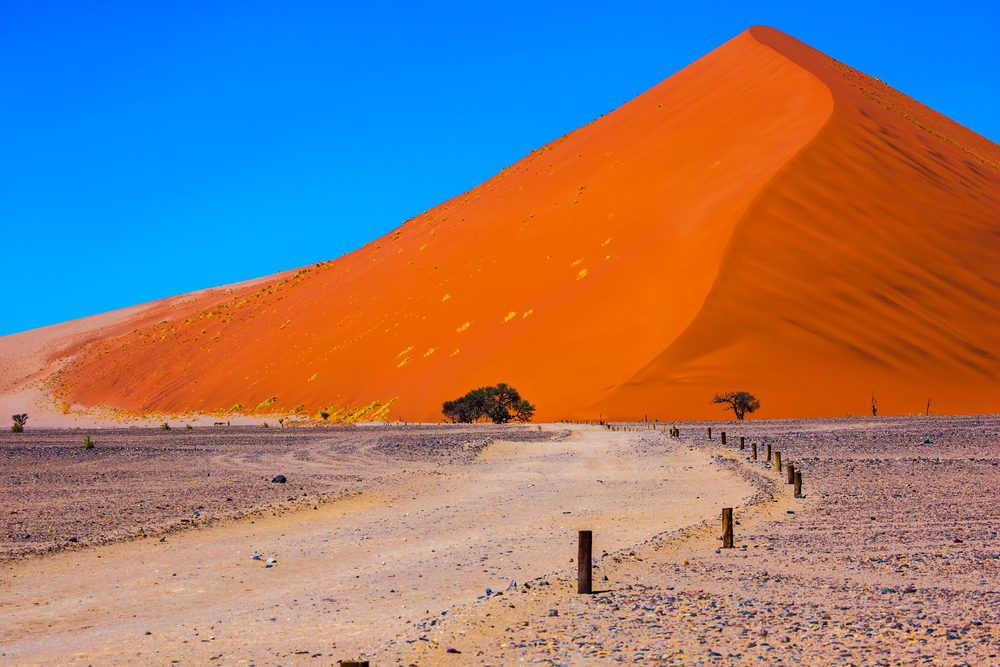
Namib-Naukluft National Park is one of the largest conservation areas in Africa, encompassing diverse landscapes, including towering sand dunes, rugged mountains, and vast plains. The park is home to unique flora and fauna, including endemic species that have adapted to the harsh desert environment. Visitors can explore various hiking trails, including the popular Olifants Valley and the Naukluft Hiking Trail, which offer breathtaking views of the landscape. The park is also a UNESCO World Heritage site, recognized for its outstanding natural beauty and ecological significance.
Kolmanskop
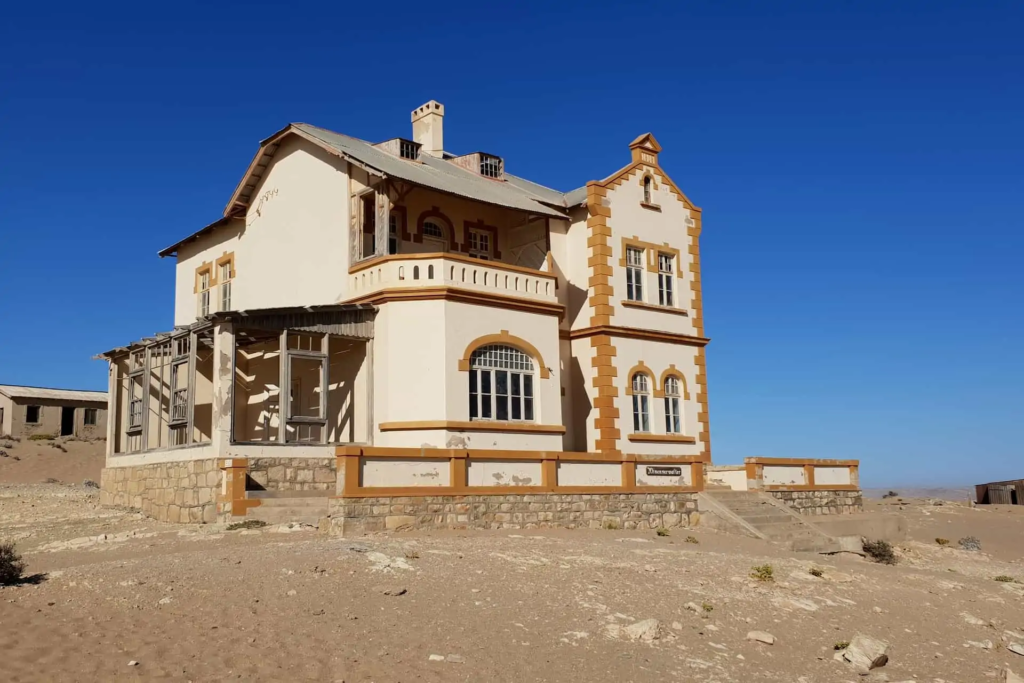
Kolmanskop is a fascinating ghost town that once thrived during the diamond mining boom in the early 20th century. Now abandoned, the town is slowly being reclaimed by the desert sands, creating a hauntingly beautiful atmosphere. Visitors can take guided tours to explore the dilapidated buildings, including the hospital, school, and theater, while learning about the history of the diamond rush. Kolmanskop offers a unique glimpse into Namibia’s past and is a popular destination for photographers seeking to capture its eerie beauty.
Cape Cross Seal Reserve
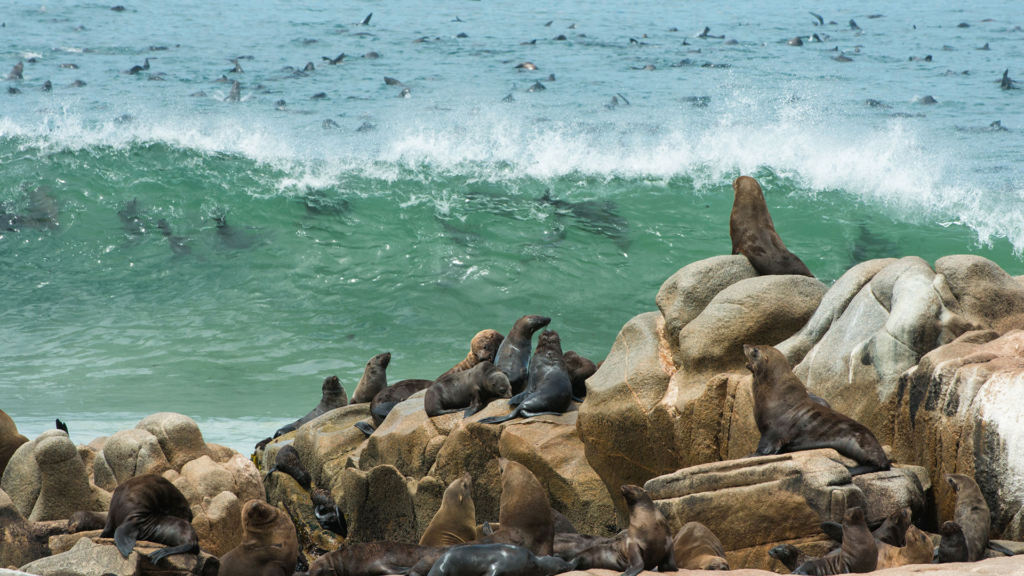
Cape Cross Seal Reserve is home to one of the largest Cape fur seal colonies in the world, with thousands of seals gathering on the rocky shores. Visitors can observe the seals in their natural habitat and learn about the conservation efforts to protect these marine mammals. The reserve also features a historical landmark, the Cape Cross, which marks the site where Portuguese explorer Diogo Cão first landed in 1486. The combination of wildlife viewing and historical significance makes Cape Cross a unique destination on Namibia’s coastline.
Twyfelfontein

A UNESCO World Heritage site, Twyfelfontein is famous for its ancient rock engravings and petroglyphs created by the San people thousands of years ago. The site features over 2,500 rock carvings, depicting animals and human figures, providing insight into the lives of early inhabitants. Visitors can take guided tours to learn about the significance of the engravings and the history of the area. Twyfelfontein’s cultural heritage and stunning desert landscape make it an essential stop for those interested in Namibia’s history.
Culture
Namibia is a melting pot of cultures, with over 11 different ethnic groups, each with its own unique traditions and customs. The largest ethnic group is the Ovambo, who primarily reside in the northern part of the country. Other notable groups include the Himba, San, and Herero, each contributing to the rich cultural tapestry of Namibia. The country’s cultural diversity is reflected in its music, dance, and art, which often celebrate the traditions and stories of its people.
The official language of Namibia is English, but many other languages are spoken throughout the country, including Afrikaans, German, and indigenous languages such as Oshiwambo, Otjiherero, and San dialects. This linguistic diversity highlights the country’s multicultural identity and the influence of its colonial past.
Traditional ceremonies and rituals play a significant role in Namibian culture. For example, the Himba people are known for their unique rites of passage, which include elaborate ceremonies celebrating the transition from childhood to adulthood. These events are characterized by traditional dress, music, and dance, offering insight into the values and beliefs of the community.
Festivals
Namibia hosts a variety of vibrant festivals that celebrate its diverse cultures and traditions. One of the most important festivals is the Windhoek Carnival, known as “W
IKA,” which showcases music, dance, and colorful parades. This annual event brings together people from all walks of life to celebrate Namibian culture and promote unity among different communities.
Another significant festival is the Omagongo Festival, celebrated by the Ovambo people. This harvest festival takes place annually and involves traditional music, dance, and feasting, symbolizing gratitude for a successful harvest. The festival serves as an important occasion for community bonding and the passing down of cultural heritage.
The Himba community also hosts the “Himba Festival,” a cultural gathering that showcases their unique way of life. This festival includes traditional music, dance, and displays of traditional attire, offering visitors a chance to immerse themselves in Himba culture. Festivals like these play a crucial role in preserving Namibia’s cultural identity and fostering a sense of community among its diverse population.
Economy
Namibia’s economy is characterized by a mix of agriculture, mining, and tourism. The country is rich in natural resources, particularly minerals like diamonds, uranium, and copper. Mining contributes significantly to the national GDP and export revenues. Agriculture, particularly livestock farming and crop production, also plays a vital role in the economy, providing livelihoods for many rural communities.
Tourism has emerged as a key sector in Namibia’s economy, attracting visitors to its stunning landscapes and wildlife. The government has prioritized sustainable tourism, aiming to protect the environment while promoting economic growth. National parks and conservation areas are central to Namibia’s tourism strategy, drawing nature enthusiasts and adventure seekers from around the world.
Cuisine
Namibian cuisine is diverse and reflects the country’s cultural influences. Traditional dishes often feature meat, particularly beef, game, and poultry, accompanied by staple foods like maize and potatoes. One popular dish is “biltong,” a dried, cured meat that is a favorite snack among locals. “Pap,” a maize porridge, is commonly served as a side dish, while “potjiekos,” a slow-cooked stew, is enjoyed during communal gatherings.
In coastal areas, seafood plays a significant role in the diet, with dishes featuring fresh fish, crab, and lobster. The blend of indigenous ingredients and flavors with colonial influences has resulted in a unique culinary experience that reflects Namibia’s rich cultural heritage.
Top Eight Most Famous Food

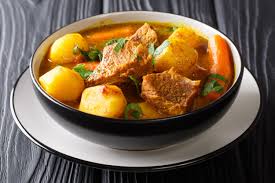
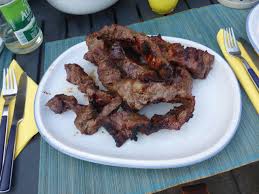
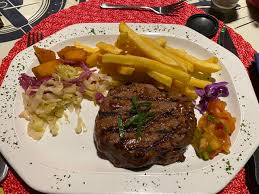

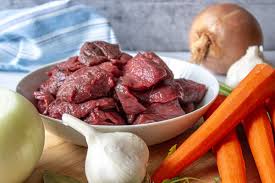
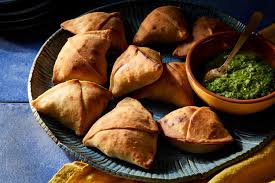

Interesting Facts
- Namibia is home to the world’s oldest desert, the Namib Desert, which is estimated to be around 55 million years old.
- The country has one of the lowest population densities in the world, with around 3 million people living in an area of over 825,000 square kilometers.
- Etosha National Park is one of the largest game reserves in Africa and is known for its unique salt pan.
- The Namib Desert is famous for its striking red dunes, which can reach heights of over 300 meters.
- Namibia gained independence from South Africa on March 21, 1990, after a long struggle for liberation.
- The Himba people are known for their distinctive red ochre body paint and unique hairstyles, which signify their cultural identity.
- Namibia is home to the largest population of desert-adapted elephants in the world.
- The country’s official language is English, but over ten indigenous languages are spoken by various ethnic groups.
- Kolmanskop, a ghost town, was once a thriving diamond mining community in the early 1900s.
- The Fish River Canyon is one of the largest canyons in the world and offers breathtaking views and hiking opportunities.
Conclusion
Namibia is a land of captivating landscapes, rich cultural heritage, and a resilient spirit. From the towering dunes of Sossusvlei to the wildlife-rich Etosha National Park, the country’s natural beauty is matched only by the diversity of its people. With a history shaped by ancient traditions and the struggle for independence, Namibia stands as a testament to the strength and resilience of its inhabitants. As travelers explore its endless horizons, they are invited to discover the stories, cultures, and wonders that make Namibia a truly remarkable destination.
let’s enjoy few years on earth with peace and happiness….✍🏼🙏

